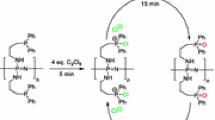Abstract
Polyphosphonates, polyphosphates, polyarylazophosphonates and polyarylazophosphates were synthesized by a new alternative to the classical phase transfer catalysis, respectively, the modified inverse phase transfer catalysis (IPTC) polycondensation of various phenylphosphonic (phosphoric) dichlorides (phenylphosphonic dichloride, phenylphosphoric dichloride, p-chlorophenylphosphoric dichloride) with bisphenols: bisphenol A, tetrabromobisphenol A, bis-(4-hydroxyphenyl)methane (bisphenol F), 4,4′-dihydroxyazobenzene. The polymers were characterized by infrared spectroscopy and magnetic resonance (1H-NMR, 31P-NMR, 13C-NMR) spectroscopy. Yields in the range of 63.5–85% and molecular weights (M w) of ~2,000–8,200 g mol−1 were obtained. Polyphosphonates were stable up 210–270 °C and polyphosphates up 190–220 °C in air atmosphere. For a correct estimation of the thermal behavior of similar compounds, a kinetic analysis using a modified version of Non Parametric Kinetic method for representative polyphosphonate and polyphosphate was realized. The studies made on the hydrolytic degradation of the synthesized polyphosphates show that the most stable polymer under alkali-catalyzed degradation is the polyphosphate obtained by IPTC of phenylphosphoric dichloride and bisphenol A.




Similar content being viewed by others
References
Roy S, Maiti SJ (2001) Design of multiple flame-retardant polymers. Appl Polym Sci 84:785–792
Chaubal MV, Gupta AS, Lopina ST, Bruley DF (2004) Polyphosphates and other phosphorus containing polymers for drug delivery applications. Crit Rev Ther Drug Carrier Syst 20:295–513
Gupta AN, Lopina ST (2004) Synthesis and characterization of l-tyrosine based novel polyphosphates for potential biomaterial applications. Polymer 45:4653–4662
Leong KW (1990) Biodegradable polyphosphoesters. Eur Pat Appl 0386757
Millich F, Lambing LL (1980) Interfacial synthesis of polyphosphonate and polyphosphate esters.VII. Temperature effects and reaction loci in polycondensations of hydroquinone with phenylphosphonic dichloride and 4-methylthiophenil phosphorodichloridate. J Polym Sci Polym Chem Ed 18:2155–2162
Imai Y, Kamata H, Kakimoto M-A (1984) Preparation and properies of high transition temperature aromatic polyphosphonates by phase-transfer-catalyzed polycondensation of phenylphosphonic dichloride with bisphenols. J Polym Sci Polym Chem Ed 22:1259–1265
Roy S, Maiti S (2001) Synthesis and characterization of unsaturated polyphosphonates. J Polym Mat 17:267–282
Iliescu S, Ilia G, Popa A, Dehelean G, Macarie L, Pacureanu L, Hurduc N (2001) Polyphosphonates obtained by vapor-liquid interfacial polycondensation. Polym Bull 46:165–170
Narendran N, Kishore KJ (2003) Studies on polyphosophate esters synthesis. Appl Polym Sci 87:626–631
Starks CM, Liotta CL, Halpern M (1994) Phase transfer catalysis; fundamentals, applications and industrial perspectives, chap. 9. Chapmen & Hall, New York
Mathias LJ, Vaidya RA (1986) Inverse phase transfer catalysis. First report of a new class of interfacial reactions. J Am Chem Soc 108:1093–1094
Iliescu S, Ilia G, Pascariu A, Popa A, Plesu N (2006) Novel synthesis of phosphorus containing polymers under inverse phase transfer catalysis. Polymer 47:6509–6512
Nuyken O (1985) Azo-polymers. In: Mark HF et al (eds) Encyclopaedia of polymer science and engineering. Wiley, New York, p 158
Baran J, Penczek S (1995) Hydrolysis of polyesters of phosphoric acid. Macromolecules 28:5167–5176
Vlase T, Vlase G, Doca N (2005) Thermal stability of food additives of glutamate and benzoate type. J Therm Anal Calorim 80:425–428
Serra R, Sempere J, Nomen R (1998) A new method for the kinetic study of thermoanalytical data: the non-parametric kinetics method. Thermochim Acta 316:37–45
Sestak J, Berggren G (1971) Study of the kinetics of the mechanism of solid-state reactions at increasing temperatures. Thermochim Acta 3:1–12
Acknowledgments
This study was financially supported by CNCSIS GR 94/2008. The authors are grateful to Professor Stefan Berger, Institute for Analytical Chemistry, Leipzig for providing access to the NMR spectrometer and Dr. Ecaterina Avram, Petru Poni Institute of Macromolecular Chemistry, Iasi, for molecular weights determination.
Author information
Authors and Affiliations
Corresponding author
Rights and permissions
About this article
Cite this article
Iliescu, S., Pascariu, A., Plesu, N. et al. Unconventional method used in synthesis of polyphosphoesters. Polym. Bull. 63, 485–495 (2009). https://doi.org/10.1007/s00289-009-0107-2
Received:
Revised:
Accepted:
Published:
Issue Date:
DOI: https://doi.org/10.1007/s00289-009-0107-2




